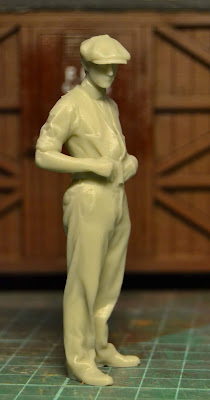After a long time, part spent working hard with preparations for the InnoTrans exhibition in Berlin, I am finally able to present my fourth finished 16 mm scale model. The I. P. Engineering kit of an early Ffestiniog brake van.
 |
| Smoke from steam engines have made the little brake van quite dirty. The staff in the work shop have welded together a short track panel. Nystrup Gravel's first 32 mm gauge track. |
The model was
built out of the box except for a minor reconstruction to allow body and chassis to be separated for maintenance and the adding of small details here and there. I added lamp brackets, bolts on the brake stand, door hinges and the large square bolt heads on both ends. I also rebuilt the buffers to be fitted with underslung coupling chains. The chains and hooks will be added later.
 |
| Cloth cover being glued on with diluted white glue. |
 |
| Primed and ready for the cover paint. |
After fixing the roofs and adding tissue paper as cloth cover, I primed the whole upper body with Chaos Black and airbrushed it with Vallejo Air 71036 'Mahogany'. I added the decals from the kit, but used only the FRC and number. The decals needed much work to fit snuggly into the grooves between the planks. I had to cut the decals along the grooves to assist the decal fluid in making the decals fit.
I then used a wire brush to remove paint from worn areas and followed up with acrylic and oil paint as well as chalk powder to add weathering.The mahogany paint is gloss so I had to give the completed model a final covering of matt varnish. The varnish also helps protect the weathering.
 |
| The mahogany paint is on and the roof is painted dark grey. I almost managed to avoid overspray, but you may notice a little grey in the upper right corner of the wagon. |
 |
| In this image it seems like the work shop staff have wiped the lettering clean from dirt. In reality it is some kind of reaction between my decal solution, paint and varnish I haven't seen before. Every model teaches me something new. |
Not being too familiar with the real brake vans I have nevertheless spotted some differences between drawings, different models and images of the original and the FR's new replica. Drawings of van 1 and 2 in Narrow Gauge and Industrial Modelling Review 38 and Steve Holland's build article of a Triassic Modelworks' kit in Review 78 helped during my build. Despite my doubts if the model is correct in every detail I think it is a good kit and will recommend it, not least because of its easy construction. Should I wish for one thing it would be the exchange of the wooden handrail on the brake platform with a metal part. I may fix that on my own model sometime in the future.
To add a splash of colour to this post's rather brown and dark grey impression, I have included two images from InnoTrans 2018. My part of the exhibition was concentrated mainly on relevant permanent way equipment and consequently a lot of my pictures are of yellow vehicles.
 |
| A Linsinger rail milling vehicle. |
 |
| Two-way quad bike. A handy little thing for those small surveying tasks along the line. |

























